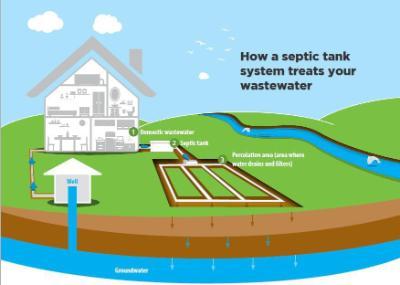‘A well-maintained septic tank system will protect your health, your environment and your pocket’
Septic tank and other domestic waste water treatment systems are used by rural home owners to treat waste water from their homes. There are nearly half a million of these systems in Ireland. The majority are septic tank systems, with some more complex filter systems and mechanical treatment plants.
How does a septic tank system work?
What are the health and environmental risks?
What can you do if you are concerned?

Domestic waste water from toilets, sinks, showers, washing machines and dishwashers goes to the septic tank system.
The solids settle out and form a sludge which needs to be emptied from time to time to prevent blockage. The liquid flows on through the tank and out into a network of shallow underground pipes (called a percolation area). The pipes have small holes that release the liquid so it can filter down through the soil. The liquid is naturally treated as it moves down through the soil before it reaches the groundwater below.
The most basic type of system is a septic tank and percolation area.
If a site is not suitable for a standard septic tank and percolation area, there are other options. You can add a filtering system to the septic tank, e.g.
or you can choose a mechanical treatment plant.
Septic tank systems are designed to remove pollution and release treated waste water safely into the environment. However, they are a risk to human health and the environment if they are not constructed and maintained properly.
Poorly treated waste water from faulty septic tank systems can contaminate nearby household wells with harmful bacteria and viruses. There are about 165,000 households in Ireland with a septic tank system and a well.
Studies have found frequent occurrences of bacteria in groundwater and household wells. Infants, pregnant women, the elderly and people with pre-existing health conditions are particularly vulnerable.
The other human health risk is the direct exposure to waste water if the septic tank system overflows, leaks, pools in the garden or flows to ditches and streams.
Poorly treated waste water may contain excessive amounts of phosphorus and nitrogen, which can pollute rivers, lakes and coastal waters. Septic tank systems have been identified as a potential source of pollution in some stretches of rivers.
Check out our web pages about septic tank maintenance and repair/replacement If problems are persistent, get a professional to assess the system to determine what is required.
Have you completed a septic tank system check?
You can also find guidance on our webpage on household wells. You should have your well tested at least annually, particularly after heavy rain, to make sure your drinking water is safe. If you suspect that your septic tank system is affecting your well, you should get the well and septic tank system checked by a suitably qualified person.
Have you checked your well water supply?
| Who? | Responsibilities |
|---|---|
| Homeowners |
Registration Proper operation and maintenance Prevent risk to the environment or human health |
| Wastewater professionals |
Site assessment in line with Code of Practice (site assessors) Compliance with standards and labeling rules (suppliers) Installation in line with the Code, building regulations, and standards (architects, engineers, builders, etc.). |
| City and County Councils |
Application to register with Protect Our Water Planning and building control Inspections Grants for septic tank systems and wells Identifying potentially polluting septic tanks (Local Authority Waters Programme Office) Investigation of septic tank complaints |
| Environmental Protection Agency |
National Inspection Plan National reports |
| National Standards Authority of Ireland | European/Irish standards |
| Department of Housing, Planning and Local Government |
Funding of grants Coordination and guidance under the Building Regulations. |
Planning applications for new houses must show that the site is suitable for the proposed septic tank system and meets the requirements in:
The 2021 Code of Practice applies to site assessments and associated installations carried out on or after 7th June 2021.
The 2009 Code of Practice may be used for site assessments and associated installations commenced before the 7th June 2021 or where planning permission has been applied for before that date.
The homeowner must engage a suitably qualified person who will visit the site and test the ground to check that:
The assessor will also work out what type of waste water treatment systems are suitable for the site.
If a site is not suitable for a standard percolation area, there may be other options. You can add a filtering system to the septic tank, e.g.
or you can choose a mechanical treatment plant.
Not all sites are suitable. The ultimate decision rests with the local/planning authority. Discharge to surface water as an alternative would require a Water Pollution Act license from a City or County Council.
Common questions in relation to the Code of Practice and new builds are answered below. There is also a leaflet for people building a house.
If you have a question relating to a specific site which is in the context of a planning application, you should contact your City or County Council, as they regulate septic tank systems under planning and building regulations.